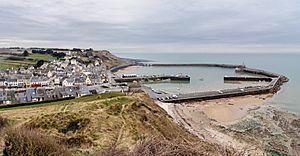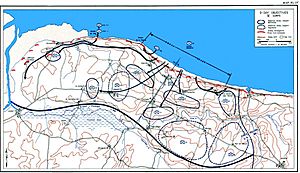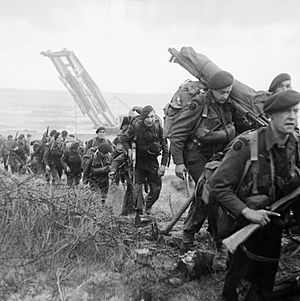Battle of Port-en-Bessin facts for kids
Quick facts for kids Battle of Port-en-Bessin |
|||||||
|---|---|---|---|---|---|---|---|
| Part of the Normandy landings | |||||||
 Recent view of Port-en-Bessin. |
|||||||
|
|||||||
| Belligerents | |||||||
| Commanders and leaders | |||||||
| Strength | |||||||
| Elements of 47 Commando: c. 420 men 328 during assault |
Elements of 352nd Division 2 Flakships |
||||||
| Casualties and losses | |||||||
| 136 casualties: 46 killed 70 wounded |
300 prisoners (incomplete) | ||||||
The Battle of Port-en-Bessin, also known as Operation Aubery, was an important fight during World War II. It happened from 7 to 8 June 1944, at a small fishing port called Port-en-Bessin in Normandy, France. This battle was part of the huge Normandy landings (also known as D-Day).
Port-en-Bessin was located right between two major landing zones: Omaha Beach (used by American forces) and Gold Beach (used by British forces). Capturing this fortified port was a key goal of Operation Overlord, the overall plan for the D-Day invasion. The port was successfully taken by No. 47 (Royal Marine) Commando, a special British military unit.
Contents
Why Port-en-Bessin Was Important
The port of Port-en-Bessin was a vital target for the Allies. It was located between the American and British landing beaches. This made it a perfect spot for a new command center for General B. L. Montgomery, who was in charge of the Allied ground forces.
More importantly, the Allies planned to set up large fuel depots near the port. These depots would store petrol and oil needed for all the tanks, trucks, and other vehicles. Fuel would be brought in by tankers offshore and pumped through special pipelines directly into the depots. The first pipeline to Port-en-Bessin opened on 25 June, showing how crucial the port was for supplying the invasion.
Getting Ready for Battle
The Journey to Normandy
The soldiers of 47 RM Commando got onto their transport ships on 3 June 1944. They left England on 5 June. Early on D-Day, 6 June, at 5:00 a.m., they were about 8 miles (13 km) off the coast of Normandy. They then moved into 14 smaller Landing Craft Assault (LCA) boats, each carrying 30 marines. Their target was Gold Beach.
Facing Danger at Sea
As the LCAs moved closer to shore, large German guns at Le Hamel and Longues began firing at them. One LCA was hit and sank, causing 12 marines to be killed or drowned. Eleven others were badly hurt but still made it to shore.
The remaining LCAs had to cross a wide area filled with "Belgian Gates." These were steel barriers, many with mines attached. The rising tide covered many of these obstacles. This meant the marines couldn't remove them. Four LCAs were pierced and sank because of the hidden explosives. Some marines had to swim ashore. In total, 43 men and much of their radio equipment were lost during this difficult landing.
Moving Inland
After gathering on the beach, 47 (RM) Commando had about 300 men left. They had lost 28 killed or drowned, 21 wounded, and 27 missing. They borrowed a radio from another unit and began their march across the countryside towards Port-en-Bessin.
The marines were told to avoid German troops near Longues-sur-Mer. Instead, they moved inland before heading west for the port. Their goal was to meet up with the American forces advancing from Omaha Beach. In the early evening, the commandos met German troops at La Rosière. One commando was killed and eleven were wounded in this clash. The marines took German weapons and equipment to replace what they had lost. By sunset, 47 Commando reached Point 72 at Escures, about 1.5 miles (2.4 km) from the port. They dug in there to prepare for an attack on the German positions around Port-en-Bessin the next morning.
The Battle for Port-en-Bessin
Attacking the Port's Defenses
The main defenses of Port-en-Bessin were on two high cliffs, about 200 feet (61 m) tall, on either side of the port. These were called the Western and Eastern features. The Germans had also built a strong, dug-in position just south of the port on the road to Bayeux. There were more defenses right in the harbor area.
Before their radio was fixed to call for covering fire, the marines began fighting house-to-house through the port. They quickly attacked and captured the German position on the Bayeux road. In the afternoon, British warships like HMS Emerald and Typhoon planes fired rockets at the German positions. After this, the commandos attacked the strong points on top of the cliffs and captured the base of the western cliff.
Fierce Fighting on the Cliffs
One group of marines advanced on the eastern cliff. They faced heavy rifle and machine-gun fire, plus grenades thrown down the slope. The slope was also mined and had hidden flame-throwers. As the marines moved up, two German anti-aircraft (FLAK) ships in the harbor opened fire. This attack was devastating, killing 12 and wounding 17 men in just a few minutes. More than half the troop was lost, forcing them to pull back.
German counter-attacks pushed back the commando's rear headquarters. An attack across the Escures–Port-en-Bessin road cut off the troop defending Escures. The number of commandos in the port dropped to 280, and many were wounded. However, a shortage of ammunition was solved when members of 522 Company Royal Army Service Corps bravely drove supplies through German machine-gun and tank fire.
Clearing the Harbor
The German defenses in the harbor were spread out in strong points. The marines attacked these one by one, slowly clearing the harbor in a series of tough fights. The FLAK ships kept firing, and ammunition started to run low again.
Marine Captain Cousins led a small group to scout the eastern cliff. He found a hidden, undefended zig-zag path leading up to the fortifications at the top. As darkness fell, Cousins led four officers and 25 men up the hill without being seen. They surprised the German defenders, who became confused.
The marines then came across a concrete bunker. Captain Cousins and four men bravely rushed it. Cousins was killed by a grenade, and the men with him were wounded, but the German bunker was captured. Even though they were outnumbered four to one, the marines fought their way up the cliff. They battled through concrete defenses, trenches, mines, and barbed wire. They captured German positions one by one. Before dawn, the eastern cliff was fully taken.
The fall of the Eastern Feature convinced the remaining Germans on the Western Feature to surrender. Captain Terry Cousins was suggested for the Victoria Cross, a very high award, for his bravery, but it was not given. The commandos then re-occupied Escures. At 4:00 a.m. on 8 June, the German commander and 300 of his men surrendered.
After the Battle
Casualties
The 47 (Royal Marine) Commando suffered 136 casualties during the battle. This included 46 men killed and 70 wounded.
See also




